
We all grew up believing that singing Auld Lang Syne means looking back at the past before celebrating a new year. The song almost always comes up after Christmas, and the iconic song became somewhat of a sign that another New Year approaches. Did you ever wonder about the origin of the famous song? How did it become the usual song greeting every New Year?
No need to wonder any longer. We found the simplest way to explain the Auld Lang Syne meaning without sounding too festive. Back then, people didn’t pair Auld Lang Syne with any holiday. And it’s origins include someone receiving credit for writing it when he heard it from someone else. If you want to know more, go ahead and read what we discovered about the classic New Year jingle.
Story Behind The Famed New Year Song, Auld Lang Syne

To learn the roots of Auld Lang Syne, you must first look closely at the song itself. In 1788, Scottish poet Robert Burns received credit for writing its lyrics. However, Burns soon admitted that he only compiled the verse he heard from an old man. He just got credit for formally writing it all down.
Unbeknownst to many, James Watson composed an earlier ballad named “Old Long Syne” in 1711. Sounds familiar, right? It gets even more intriguing. In the 17th century, Robert Ayton and Allan Ramsay wrote poems with the same title. All this information proves that no one can trace who actually wrote and composed the song.
In 1929, the USA tuned in to Auld Lang Syne on the radio. Singing the song in the country became part of the New Year tradition thanks to the annual New Year’s TV broadcast of Guy Lombardo and the Royal Canadians. He gained the title “Mr. New Year’s Eve” for showcasing a festive performance with his big band tunes. They always played the memorable tune during their annual program. His broadcast maintained high viewership for decades.
Lombardo eventually found competition in Dick Clarke’s “New Year’s Rockin’ Eve,” which attracted younger viewers. Because of Lombardo’s annual broadcast, most Americans greet New Year’s Eve by singing Auld Lang Syne. This practice soon influenced other countries, making Auld Lang Syne a staple of New Year traditions across the world.
See Why People Are Puzzled With The Auld Lang Syne Lyrics
As a New Year approaches, carolers usually sing the famed Auld Lang Syne like this:
“Auld Lang Syne”
First verse:
Should auld acquaintance be forgot,
and never brought to mind?
Should auld acquaintance be forgot,
and auld lang syne*?
Chorus:
For auld lang syne, my jo,
for auld lang syne,
we’ll tak’ a cup o’ kindness yet,
for auld lang syne.
Second verse:
And surely ye’ll be your pint-stoup!
and surely I’ll be mine!
And we’ll tak’ a cup o’ kindness yet,
for auld lang syne.
Third verse:
We twa hae run about the braes,
and pou’d the gowans fine;
But we’ve wander’d mony a weary fit,
sin’ auld lang syne.
Fourth verse:
We twa hae paidl’d in the burn,
frae morning sun till dine;
But seas between us braid hae roar’d
sin’ auld lang syne.
Fifth verse:
And there’s a hand,
my trusty fiere!
and gie’s a hand o’ thine!
And we’ll tak’ a right gude-willie waught,
for auld lang syne.
The modern English translation goes like this:
“Time Goes By”
Should old acquaintances be forgotten,
And never brought to mind?
Should old acquaintances be forgotten,
And days of long ago!
Chorus:
For times gone by, my dear
For times gone by,
We will take a cup of kindness yet
For times gone by.
We two have run about the hillsides
And pulled the daisies fine,
But we have wandered many a weary foot
For times gone by.
We two have paddled (or waded) in the stream
From noon until dinner time,
But seas between us broad have roared
Since times gone by.
And there is a hand, my trusty friend,
And give us a hand of yours,
And we will take a goodwill drink (of ale)
For times gone by!
And surely you will pay for your pint,
And surely I will pay for mine!
And we will take a cup of kindness yet
For times gone by!
This article belongs to Facts.net and may not be reproduced, copied, edited, published, transmitted, or uploaded in any way without the permission of Facts.net.
Learn How The New Year Song Goes Beyond Its Literal Translation
Upon reading the English translation, we can’t help but feel puzzled about the song’s story. It doesn’t seem to be connected to New Year or any holidays.
Lines such as “We twa hae run about the braes / and pou’d the gowans fine” comes as a mix of English and gibberish to most people. A lot of people still don’t know that Auld Lang Syne came from the 18th-century Scottish language. They just sing along whenever it comes on the radio every New Year’s Eve.
Scots famously celebrate Hogmanay instead of calling the holiday New Year’s Eve. They would celebrate their beloved event for a few days beginning on December 31. Throughout history, Scotland did not celebrate Christmas. They put out all their efforts to commemorate Hogmanay instead. With this, some would say that the strength of the Scottish culture’s love for New Year brought about Auld lang Syne’s fame.
So, what is the REAL Auld Lang Syne Meaning in the Scottish language?

Translators roughly determined that “Auld Lang Syne” means “Time Goes By” in today’s modern English. The song title’s literal translation is “Old Long Since.” With this, you probably noticed how “Time Goes By” makes more sense.
In case you didn’t know, the Scottish speak English with an accent just like the British and the Irish. However, they also use Scottish Gaelic from time to time. The somewhat rare language lost its meaning due to the Scottish people’s struggle of securing independence. Because of this, no one can confidently identify the Scottish dialect used in the beloved song.
Discover The Festive And Not So Festive Auld Lang Syne History

In the film When Harry Met Sally, Meg Ryan’s character mentions that the famed New year song revolves around the meeting of old friends. The whole film’s plot centered around those iconic lines, giving the story further depth and sentimentality.
To fully understand Auld Lang Syne’s meaning, you must set it aside from the holiday linked to it. The gist of the song centers on the much-awaited reunion of old friends. That’s it. It doesn’t make sense as a New Year’s eve song, but we can put the song’s story in a different perspective to relate it to the holidays.
The holidays revolve around families coming together to celebrate Thanksgiving, Christmas, and New Year’s Eve. Thus, old friends can also reunite to celebrate the festive season. The writer of Auld Lang Syne did not think of the holidays while writing it but time had shown that it’s always meant to be the unforgettable hymn that it is today.
Was this page helpful?
Our commitment to delivering trustworthy and engaging content is at the heart of what we do. Each fact on our site is contributed by real users like you, bringing a wealth of diverse insights and information. To ensure the highest standards of accuracy and reliability, our dedicated editors meticulously review each submission. This process guarantees that the facts we share are not only fascinating but also credible. Trust in our commitment to quality and authenticity as you explore and learn with us.
